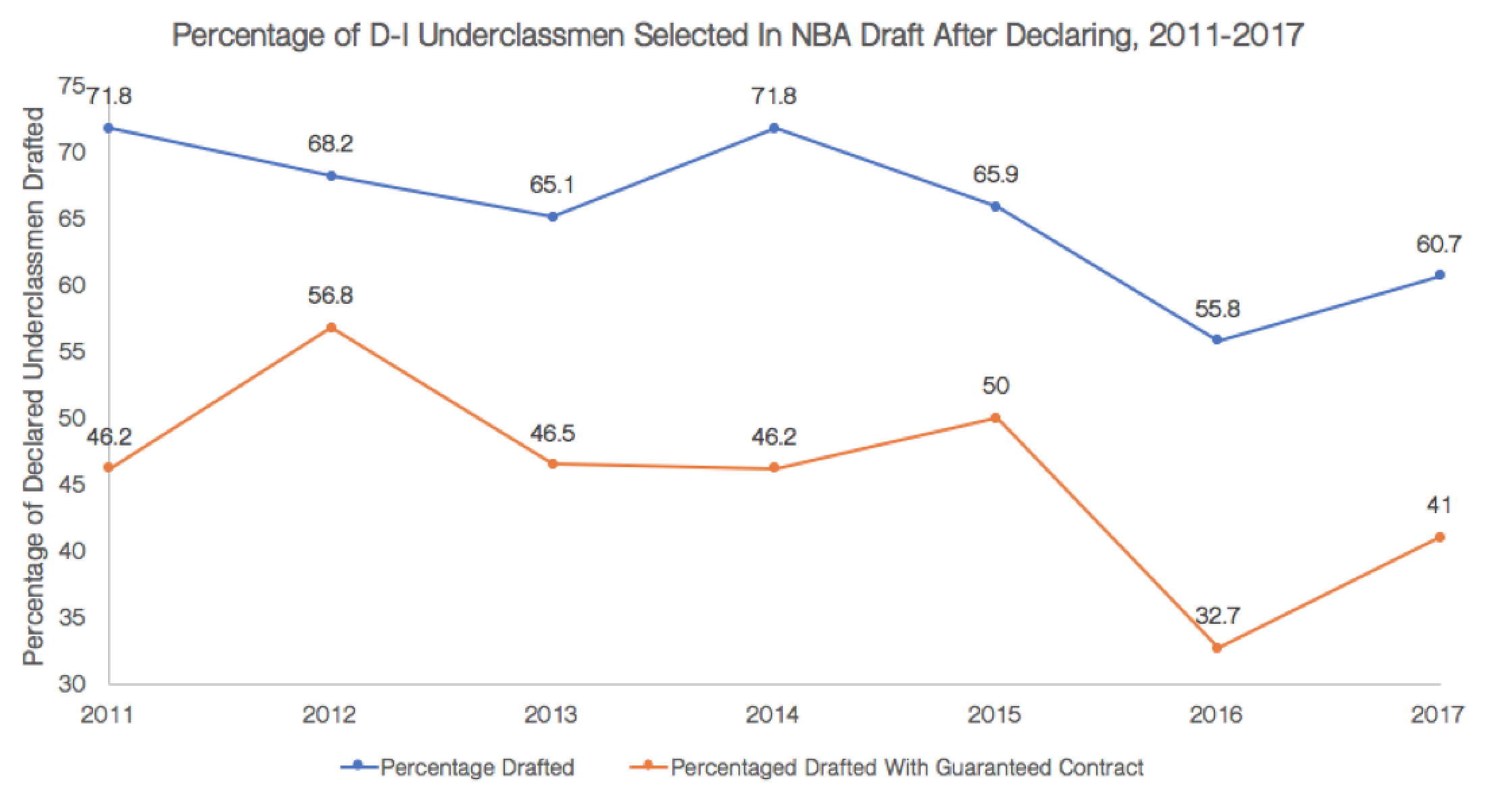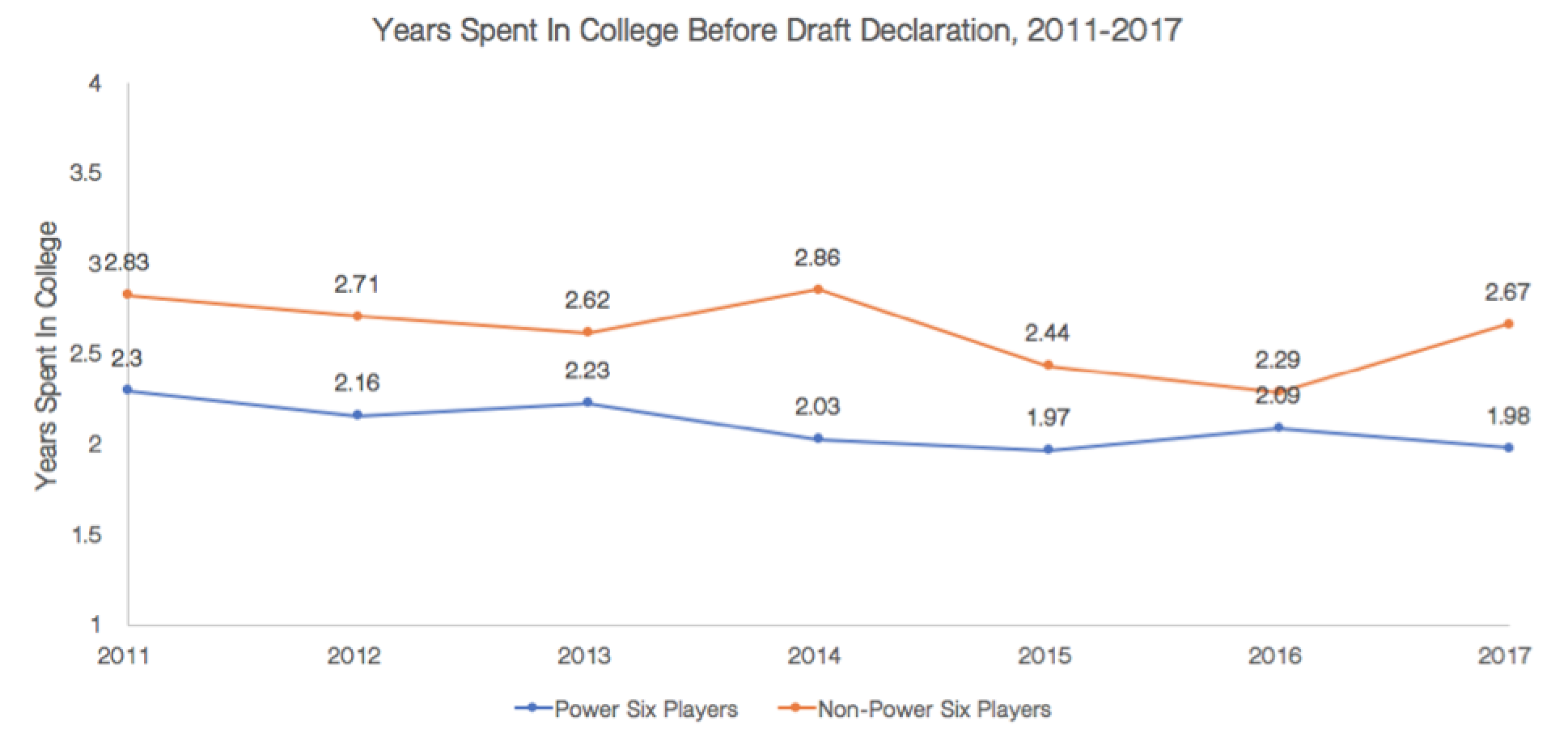As the spring progresses, many familiar (and some unfamiliar) underclassmen will enter their names into the 2018 NBA Draft class. College basketball has long been impacted by NBA hopefuls, especially in today’s so-called “one-and-done era,” leaving early for the NBA Draft. This article takes a deep dive into the recent history of NBA Draft declarations and its trends over the past eight seasons.
Prior to 2016, players that declared for the NBA Draft automatically forfeited their collegiate eligibility and could not return to school, regardless of whether they were selected in the draft. In March of 2015, a new rule was proposed by the National Association of Basketball Coaches (NABC) and later passed that allowed players to declare for the draft and return to school as long as the player did not sign with an agent.
As a result, there has been a noticeable spike in players declaring (and staying) in the draft pool since 2016. Between 2011 and 2015, an average of 41.8 underclassmen declared and signed with an agent per draft class. Since the rule was passed, 52 underclassmen declared and signed with an agent in 2016 and 61 did the same in 2017.
The most notable question figures to ask how often declared players are selected in their respective draft classes. The 2016 NBA Draft had the lowest percentage of underclassmen declarations selected in at least six years. Between 2011 and 2015, under previous eligibility rules, 68.6% of declared underclassmen were drafted, but only 55.8% and 60.7% of declared players were drafted in 2016 and 2017.
One of the key takeaways from the above graph was the remarkable drop in percentage of guaranteed contracts for declared underclassmen between 2015 and 2016. Half of the underclassmen that declared in 2015 received a guaranteed rookie contract by being selected in the draft’s first round. In 2016, however, the percentage declined all the way to just 32.7%, as 52 underclassmen declared with an agent but just 17 were among the draft’s first 30 selections.
As most would anticipate, the majority of NBA Draft declarations come from players in high-major conferences (ACC, Big Ten, Big XII, Big East, Pac-12, and SEC). The table below shows each conference’s share of the total underclassmen declarations between 2011 and 2017, as well as the share of total guaranteed contracts. The net percentage subtracts each conference’s share of total guaranteed contracts by its share of total declarations.
The ACC, which compiled 17.1% of total underclassmen draft declarations the past seven years, made up nearly a quarter of the total guaranteed contracts (23.4%) in the same span. The conference has had at least three first-round draft selections in each of the past seven years, including 2017’s outburst, which accounted for a whopping 10 of the draft’s 30 first round picks. With a net difference of 6.3%, the ACC has thoroughly dominated the other conferences when it comes to boasting high draft picks. Other major conferences, such as the SEC (1.1%), Big XII (1.1%) and Big East (0.6%) lag further behind.
There is a noticeable divide in the number of seasons players spend in college depending on conference affiliation. The graph below shows the average number of years players have spent in college before declaring early for the draft based on whether the player was from a high-major or mid- or low-major conference.
Over the past seven drafts, players out of high-major conferences spent an average of 2.1 years in college while players from mid- or low-major conferences spent 2.6 years before turning pro. The largest difference was in 2014, where an average of 0.83 years separated players from high-major conferences and mid- or low-major conferences. There has yet to be a season in which the average high-major player spent more years in college before declaring than the average mid- or low-major player.
Recruiting, understandably, has a substantial impact on NBA hopefuls as well. The table below shows the frequency of draft declarations based on the player’s recruiting rating and number of years of collegiate experience. Recruiting ratings are courtesy of 24/7 Sports.
Nearly half of the former five-star recruits that declare early for the draft are freshmen (49.6%), while just 15.8% of former four-star recruits and 2.6% of former three-star recruits declare as freshmen. For players that were rated four-stars or lower as high schoolers, the bulk of their draft declarations come from juniors. Just over half of former four-star recruits have been juniors since 2011 (52.6%). As for three-star and two-star recruits, 76.9% and 80.0% of the early draft entrants have been juniors, respectively. Moreover, five-star recruits that declare early spend an average of 1.69 years in school before leaving, while four-star recruits (2.37 years), three-star recruits (2.74 years), and two-star recruits (2.80 years) tend to stay in college at least an additional season to prove their worth, on average.
Our findings generally support the notions and assumptions that have been set forth in prior years. These include elite recruits declaring much earlier than two- or three-star recruits, players from high-major conferences spending fewer years in college, and a smaller share of early entrants being selected since the change in eligibility rules back in 2016. Based on the number of draft declarations since the end of this year’s regular season, we can expect a record number of early entrants for the third consecutive season. A rule designed to help improve student athlete’s decisions appears to have assisted NBA front offices more than anyone else.






